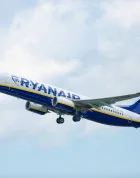I’ve often been asked for recommendations on what one should buy or pack when going on a trip with their kids, so here’s an article to summarize what I have found useful.
This list is by no means exhaustive, but hopefully it’ll serve as a starting point to make your travels smoother.
Travel Stroller
This is probably one of the most important things to pack. Most families will have a stroller they love for everyday use and if you love it enough, you can bring it on your travels as well.
Others may opt for an ultra-low weight, bare-bones umbrella stroller due to ease of use.
Let me introduce you to a third type of stroller: the travel stroller. This hybrid stroller has the functionality of an everyday stroller, and the weight and compatibility of an umbrella stroller.
The essential features are that it is lightweight and can fold down to a size that can be brought into an aircraft cabin, rather than needing to be checked at the gate.
This feature is key, because it means that once you land, you take your stroller from the overhead bin and are good to deplane, rather than having to wait for the stroller to be brought up from the cargo hold.
The best stroller I’ve found is the GB Pockit+ All-City, which is the most compact travel stroller you can find. It folds down to a size of 12.6″ × 7.9″ × 18.9″, which can fit in a large shoulder bag and accommodates a child up to 55 pounds, and weighs only 13 pounds.
For me, there are only a couple of downsides to this stroller. One is that the canopy doesn’t extend quite as far as I’d like, but you can easily buy a canopy extender to fix that problem.
Another is that it has a decent recline, but it’s not lie-flat – similar to flying on Ethiopian Airlines’s Cloud Nine vs. any airline with a proper lie-flat bed.
The price point is around $350. If you want something even smaller, lighter and cheaper, look for other GB models, like the GB Qbit LTE, the original GB Pockit, or the GB Pockit+, which can still be found in secondhand marketplaces.
I personally had the original GB Pockit and loved it, despite the shortcomings mentioned above.
A close second place contender would be the Mountain Buggy Nano Stroller, which also weighs 13 pounds. It’s not quite as compact, but offers a full recline.
Car Seats
For those with infants, you may need an infant car seat, and unfortunately, these don’t come in travel-friendly sizes. Personally, I’ve never travelled with an infant seat; rather, if my child was under the age of two, they’d travel with me as an infant-on-lap.
If we needed a car seat for a car rental, we’ve always rented them from the car rental company instead of lugging our own. Some car rental agencies have even added it at no cost.
We chose convenience, but I understand if some parents have concerns over cleanliness and safety.
If you prefer to have a separate seat for your infant on a plane, then you will need to fly with an approved child restraint system, aka car seat, on most airlines.
If your toddler is older than two, an alternative to a car seat is the CARES Child Aviation Restraint System. It gives your child the safety of chest and shoulder straps, which you would normally have with a car seat, but saves you the hassle of having to lug an actual car seat.
Weighing only one pound, it is very travel-friendly.
At $100 on Amazon, I’d highly recommend looking for one secondhand on eBay, Kijiji, or VarageSale, which is where I bought mine.
One situation where you may want to consider actually bringing a car seat is for extra “baggage” allowance, as most airlines allow families to check their car seats free of charge. Pack it nicely in a bag or carrier, then then throw as much stuff as you want with it before you check it in.
Boosters
The booster stage is a weird in-between phase, where the booster itself is small enough to bring, but still bulky enough to be a nuisance. You could rent one with your car rental, but it seems like a waste to have to pay for, as you can easily buy one for $20.
One alternative that I’ve found to be quite convenient is the Mifold Booster, which retails for $50 and up. It folds into less than a quarter of the size of a regular booster and can fit easily into a backpack or shoulder bag.
The only downside I found was that it wasn’t most ideal for kids who are just transitioning into boosters, as my daughter would often slide to the sides.
If your child is fresh into a booster like mine, you may want to opt for the Mifold Hifold Fit-and-Fold Booster.
Although larger (13.5″ × 13.5″ × 9.8″ when folded), heavier (10 pounds), and more expensive at ~$230, it is more comfortable, has additional safety features, and is adjustable in height and width to grow with your child.
Trackers
Once kids are mobile, there’s always a potential for them to go wandering and missing. The chance increases with the more kids you have, and when going to crowded places with lots of potential distractions, such as a theme park.
To cover my bases, I now put trackers on my kids when we travel. I’ve tried the Apple AirTag, Tile Pro, and Tile Mate. All are great options, range in price from $35–40, and each has their own pros and cons.
For the AirTag, you need to buy a holder, like a keychain or wrist strap, to place it in. It has the best range capabilities, as it connects to your iOS and other macOS devices over Bluetooth, so you can easily see its location on the map in the Find My app on Apple products.

The Tiles have a range limited to 250–400 ft, depending on whether you purchase the Mate or the Pro, respectively. They can easily be attached to a backpack or shoes, and can be worn as a necklace. The Pro is slightly larger and heavier than the Mate.
One benefit of the Tile over the AirTag is that your child can proactively activate it by pressing their Tile if they all of a sudden lose track of you. Your device will sound off to notify you that they’re looking for you.
Alternatively, if you can’t find your child, you can activate their Tile to start sounding off. With the AirTag, only you can activate the device to sound off.
Family Passport Pouch
When travelling with the kids, as if it’s not enough to have your stroller, carry-on, and diaper bag in tow, you’ll also have to manage several passports, boarding passes, and perhaps NEXUS cards, too.
To avoid the hassle of misplacing anything, a large passport carrier that can fit everyone’s passports is very helpful. Just go onto Amazon and you’ll find plenty of options with passport slots, zippered compartments, and card slots for all those credit cards you may be carrying as well. 😉
Packing Cubes
These are one of my favourite items for travel. It helps to keep things organized and makes it easy for kids to know where their stuff is.
Each kid has their own colour of cubes for their underwear and socks, pajamas, swim clothes, and accessories. Get the kids involved in the packing, too, by giving them their own cubes to fill up and bring back to you.
Ziplock Bags and Tupperware
You may be thinking, “Why pack containers if you’re not planning on cooking or eating in?!”
If you have young kids, it’s always nice to have extra containers for snacks. Make sure to keep a few on you and not to check them all into your luggage.
Pay a visit to an airport lounge and load up on some goldfish crackers, fresh fruit, cheese, or other small finger foods. There’s nothing like a broad range of snacks to distract a toddler or settle a hangry child, especially when complimentary meals are a thing of the past in economy class.
Containers also come in handy at hotels. Make breakfast go a little further for the little one by grabbing a few small snacks to go, like Cheerios, fruit, or yogurt. If done judiciously, you’re unlikely to run into anyone who would put up a fuss.
To save space and be environmentally-friendly, consider reusable, collapsible containers.
Kid-Friendly Headphones
It was a joyous day when all my kids could be entertained by that little screen in front of them on a plane. I was just as happy as they were.
Flyer beware: not all airlines offer kid-sized headphones and they tend to lack volume control.
Some airlines only provide ear buds that don’t fit in kids’ ears and will fall out all the time. Solution: buy kid-friendly headphones that will fit snuggly around their ears and are volume-limiting.
Consider investing in an airline headphone jack adaptor if you’re concerned about compatibility issues. Avoid wireless headphones as most entertainment systems on planes don’t have the capability to use these.
I also find that the entertainment available on airlines doesn’t usually cater well to toddlers, so consider buying a cheap tablet that you can preload with age-appropriate music and interactive apps to keep them busy.
Conclusion
There’s no question about it: travelling with kids, especially younger ones, means you’ll be travelling with a lot more stuff.
Here’s my short list of items that will hopefully make your travel experience more pleasant and help cut down on some of the research for you.
If you have any other suggestions on travel gear that has worked well for your family, please share in the comments below.


























We love the GB Pockit+ All terrain. Have been traveling with it for a few years and the set of double wheels can handle the bumpy cobble streets of so many places. Another suggestion to add as a section could be travel size carriers. We recently got the BityBean carrier since we now have two young ones and it’s super light and compact (size of a pop can) and is great for baby as well as toddler. We carry it around along with the GB and can then switch the kids between them.
good call on the family passport holder, im always fumbling around for that.